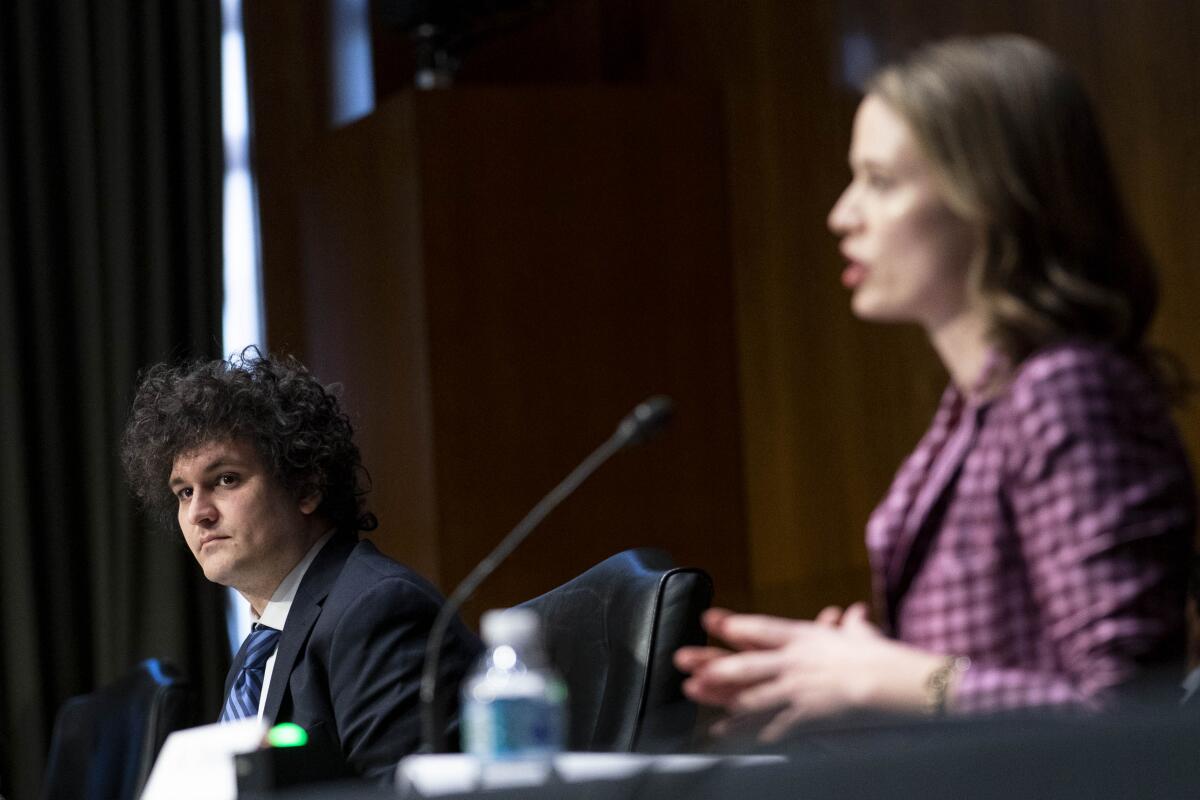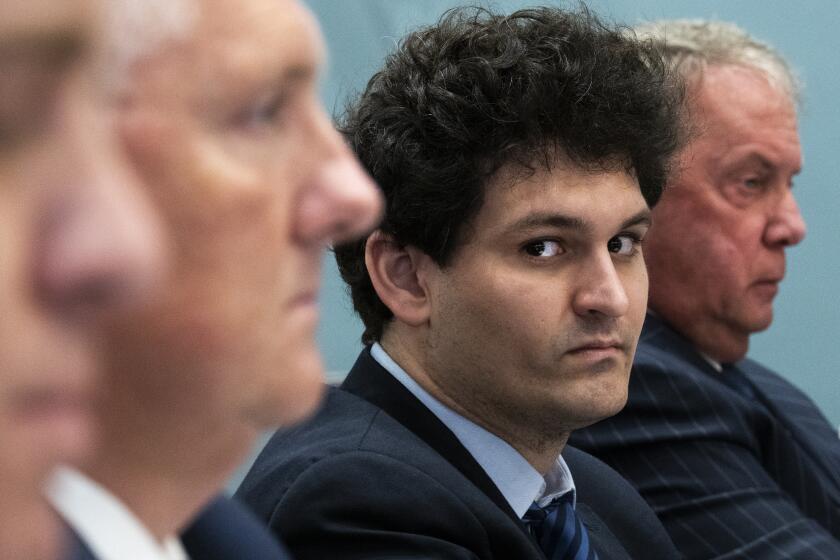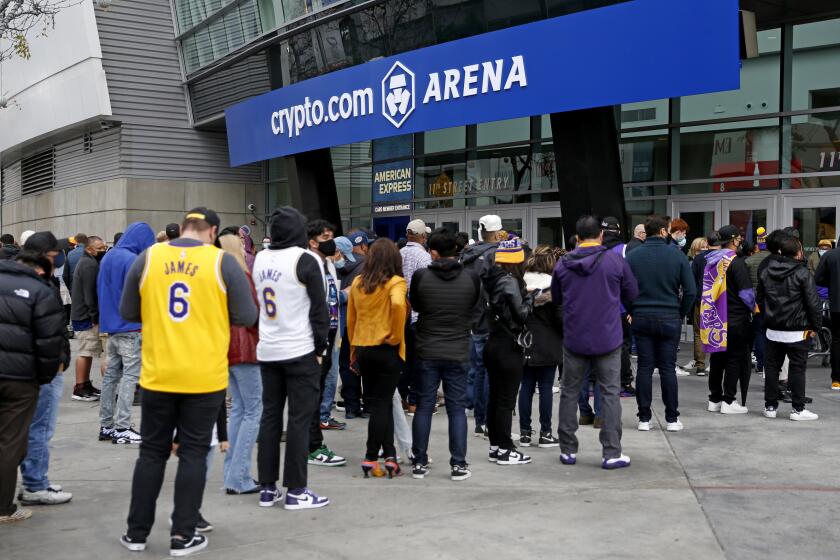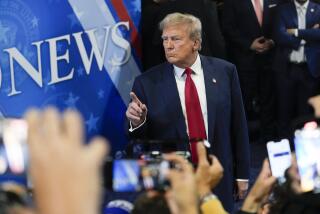Column: Crypto tycoon Sam Bankman-Fried didn’t lose a $16-billion fortune. His ‘fortune’ was never real

- Share via
The Greek tragedy unfolding in the financial press over the last week is the story of Sam Bankman-Fried, the would-be cryptocurrency tycoon and political kingmaker whose multibillion-dollar empire has sunk like the Titanic after its encounter with the iceberg.
Bloomberg put it this way: “Bankman-Fried’s Assets Plummet From $16 Billion to Zero in Days.”
The story under that headline reported that Bankman-Fried’s entire fortune had been “wiped out” in “one of history’s greatest-ever destructions of wealth.”
I, ultimately, should have been on top of everything. I clearly failed in that. I’m sorry.
— Sam Bankman-Fried
Yet, something doesn’t compute here. It’s that $16 billion in assets can’t simply disappear in a matter of days — not if they were real in the first place.
Bankman-Fried either had $16 billion in assets at the start of last week and still has a sizable share of it today, or zero now and close to zero then. Both things can’t be true.
Get the latest from Michael Hiltzik
Commentary on economics and more from a Pulitzer Prize winner.
You may occasionally receive promotional content from the Los Angeles Times.
Based on reports that Bankman-Fried and his cryptocurrency exchange firm, FTX, are now under investigation by federal prosecutors and securities regulators, I’m voting that $16 billion was mythical and that zero is the right number.
That’s not the narrative being wholesaled by the financial press and investment pundits. Their story is that Bankman-Fried had it all, then lost it all. He has played into this narrative himself, via a series of tweets last week in which he apologized for, among other things, overestimating how much he had available to pay customers who wanted to withdraw their funds from FTX.
“*I*, ultimately, should have been on top of everything,” he tweeted. “I clearly failed in that. I’m sorry.”
In other words, things were going swimmingly, until FTX hit a pothole. Bankman-Fried says he’s as surprised as you are.
Sam Bankman-Fried wanted to make cryptocurrency look legitimate. He only added to the evidence that it’s not to be trusted.
Is this plausible?
What’s known thus far, according to an FTX balance sheet published by the Financial Times, is that the firm recently had about $900 million in liquid assets against nearly $9 billion in liabilities. That means that FTX, the core of Bankman-Fried’s purported fortune, was as much as $8 billion in the hole.
Not all of those liquid assets are worth as much as the balance sheet states. It mentions about $472 million in stock of the brokerage Robinhood. But Robinhood shares have fallen in price by about 20% over the last 11 days, so that figure may be, um, optimistic by nearly $100 million.
When initial reports of FTX’s upside-down capital structure leaked out recently, customers staged a run on the exchange, ordering withdrawals of billions of dollars in deposits that FTX couldn’t provide. FTX has now filed for bankruptcy, and Bankman-Fried has stepped down as chief executive.
Reports have also emerged that FTX lent customers’ assets to its related trading arm, Alameda Research, which used them to fund risky investments of its own. If FTX were regulated by the same rules that conventional stock and bond brokerages must follow, client assets must be kept separate from brokerage assets.
Among the assets the balance sheet describes as “illiquid” or “less liquid” — that is, possibly unavailable to cover liabilities — are cryptocurrencies purportedly worth billions of dollars, including $554 million in FTT, a crypto token originated by FTX itself.
Another cryptocurrency, Serum, was listed with a value of $2.2 billion as of Thursday. The previous week, the extremely volatile crypto was valued at $5.4 billion, according to the balance sheet. Serum, by the way, is another crypto token originated by FTX, so even its $2.2-billion value on the balance sheet is extremely questionable.
Much of this was unknown to the financial community, since FTX didn’t make public disclosures. What was known, however, was that Bankman-Fried’s purported fortune was all derived from cryptocurrencies, which are notoriously volatile in price. So why was he credited with a multibillion-dollar fortune?
Column: Shame, suicide attempts, ‘financial death’ — the devastating toll of a crypto firm’s failure
Customers of the bankrupt Celsius reveal how the cryptocurrency firm’s collapse upended their lives.
One reason is the tendency of the financial press and other investment followers to accept their subjects’ claims of wealth at face value. Forbes fell into the same trap as Bloomberg, ranking Bankman-Fried 41st on its 2022 roster of the 400 richest Americans, with a net worth it estimated at $17.2 billion as of Sept. 27. Both estimates were based on a conjectural valuation of FTX at the time of a $420-million venture investing round in January.
But that’s a thin reed on which to base a multibillion-dollar estimate.
One would have hoped that the financial press would have drawn a lesson from its previous misadventure in anointing a fresh billionaire. This was the case of Elizabeth Holmes, the creator of the scam known as Theranos.
Holmes beguiled a passel of elderly male luminaries — George Shultz and Henry Kissinger among them — into joining the board of her company, which claimed to have invented a new way of testing blood that would “disrupt” the stodgy old healthcare business. In fact, Theranos didn’t have a technology that worked, only an enticing story.
Among those taken in were the staff at Forbes, which placed Holmes at No. 1 on its list of America’s richest self-made women in 2015, awarding her a net worth of $4.5 billion. The following year, after the Theranos scam was exposed, Forbes reconsidered and placed her fortune at $0.
It should be obvious that Holmes never had $4.5 billion. The magazine’s estimate was based on her 50% ownership of Theranos, which had raised $400 million from venture firms that had acquired 4.4% of the company with that investment. But Theranos didn’t have $9 billion; it only had the investment of $400 million.
The small number became the big number through the magic of venture capital math: If a 4.4% stake in a company is worth $400 million, then 100% of it must be worth about $9 billion.
The flaw in this reasoning should have been obvious: If the next round of investors demanded 50% of the company for their $400 million, then suddenly the enterprise would be worth only $800 million. And what if there were no new investors at all?
The fundamental problem was that private capital valuations are inherently suspect. Stock in private companies can’t be sold on the public market, which gives public investors a shot at acquiring shares at an agreed-on price; instead, private companies are worth only as much as their newest investors think, and their opinion can change in the blink of an eye.
Crypto was always reliant on the ‘bigger fool’ theory, and it has found its marks.
The same is true of the cryptocurrency space. Like private companies, the value of cryptocurrencies can be placed anywhere. They don’t produce income like bonds, and their prices can’t be pegged to liquid markets like those on which public company securities are traded. No one has ever explained what cryptocurrencies are useful for, other than paying off crooks holding databases or computer systems hostage in ransomware attacks.
As I reported recently, even Bankman-Fried acknowledged that claims for the usefulness of crypto involved “a lot of hand-waving.”
At some point, Bankman-Fried must have had real money. He contributed about $40 million to Democratic Party campaigns in the current election cycle.
FTX paid $135 million for the naming rights for the NBA Miami Heat arena (local authorities in Miami say they have put the naming rights to FTX Arena back out for bid), and spent heavily to produce a television commercial featuring Larry David and air it during this year’s Super Bowl.
Add up all the known expenditures, though, and it still doesn’t come close to $16 billion.
Bankman-Fried’s rise and fall in public estimation is related to our culture’s habit of compiling lists ranking any and all things — the best electric toothbrushes, the highest-yielding savings accounts, the richest plutocrats.
The grounds for many of these rankings are always murky or at least subjective, even when they seem to arise from hard numbers, as the Forbes and Bloomberg wealth lists are — poke at some of these numbers, and they deflate.
What turned Bankman-Fried into a darling of the chattering classes in finance, journalism and politics is hard to fathom. For some, it may have been his pedigree — he’s the son of two law professors and the holder of a degree from MIT.
For others, it might be his commitment to “effective altruism,” a nebulous philanthropic principle that seems to boil down to a justification for making as much money in business and finance as you conceivably can, because eventually you’re going to give it all away.
A cryptocurrency company thinks it will get a boost from putting its name on the Lakers’ arena. History begs to differ.
In May, in presenting a House committee with a proposal to relieve the crypto industry of stringent regulations, he claimed to have promised to donate 99% of his wealth to charity (an easy commitment, obviously, when you have no wealth).
The most striking aspect of the anointing of Bankman-Fried as the richest and soundest of newly minted billionaires is how so little of it has been based on hard information. The venture firm Sequoia Capital put $150 million into FTX, and followed that up by posting a slavishly adoring article about Bankman-Fried on its website.
The article reported that Sequoia’s partners decided to make their investment after a single “last-minute” Zoom call with Bankman-Fried, who is known to movers and shakers as “SBF.” The article’s author, Adam Fisher, related that after his first interview with SBF, “I was convinced: I was talking to a future trillionaire.”
Fisher, who claims to have decades of experience talking to start-up entrepreneurs, added: “I don’t know how I know, I just do. SBF is a winner.”
Sequoia has scrubbed the article from its website (I retrieved it from the Internet Archive). The firm has also assured its investors that its $150-million stake in FTX, which it has now written down to zero, was never a big deal — it accounted for only about 3% of one fund where it was parked, and 1% of another, Sequoia said.
The firm assured its backers that its FTX investment was the product of “extensive research” and “a rigorous diligence process.” (That must have been some Zoom call!)
Someone got snowed here. Maybe Bankman-Fried was snowing himself, or maybe he knew he was living a lie. The truth will probably become clearer with time.
But all the talk about Bankman-Fried suddenly losing his entire fortune isn’t designed to explain to laypersons what happened to FTX. It’s designed to hide the fact that his fans and investors made a terrific blunder. They trusted someone who hadn’t earned their trust. It isn’t the first time, and the saddest aspect of this fiasco is that it won’t be the last.
More to Read
Get the latest from Michael Hiltzik
Commentary on economics and more from a Pulitzer Prize winner.
You may occasionally receive promotional content from the Los Angeles Times.















